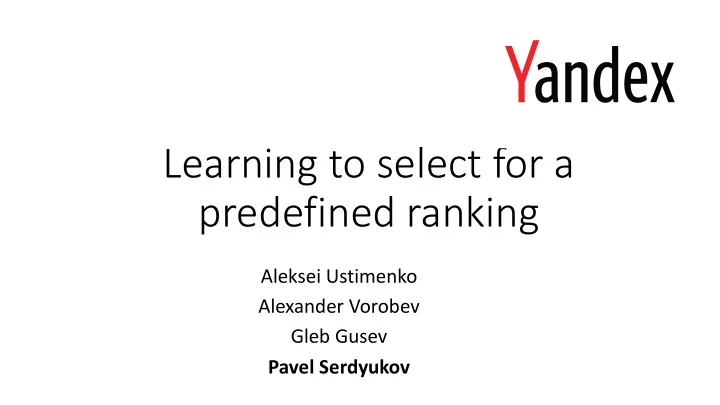

Learning to select for a predefined ranking Aleksei Ustimenko Alexander Vorobev Gleb Gusev Pavel Serdyukov
From ranking to sorting • Search engines typically order the items by some relevance score obtained from a ranker before presenting the items to the user • Yet, online shops and social networks allow the user to rearrange the items using some dedicated attribute (e.g. price or time)
From ranking To sorting
Threshold relevance? • It was proven that filtering with a constant threshold for relevance is suboptimal (in terms of ranking quality metrics like DCG) • The optimal algorithm was suggested by (Spirin et. at at SIGIR 2015), but it has quadratic complexity O (n 2 ) , where n – is the list size • Such algorithms are infeasible for search engines, we need to predict if to filter an item by just using item features (locally), not the entire list (globally)
LSO Problem Formulation • We define a selection algorithm as 𝐺 and the result of its to be the selected 𝑀 # application to a list 𝑀 • 𝑀 # - the same ordered list as 𝑀 , but with some items filtered • We formulate the problem of LSO as learning from 𝐸 a selection algorithm 𝐺 that maximizes the expected ranking quality Q of 𝑀 # , where 𝑀 is sampled from some 𝑄 : F ∗ = arg max 𝔽 /~1 𝑅(𝑀 # )
Optimal Selection Predictor • First, we suggest to build a model 𝑁 that predicts the binary decision of the infeasible optimal algorithm • Then we train a binary classifier 𝑁 on the training examples obtained from that algorithm 𝑦 78 , 𝑃𝑞𝑢 78 7: / > ∈@,8AB..D > by minimizing logistic loss • However, the logistic loss of such a classifier is still not directly related to ranking quality Q , i.e. it is not a listwise learning-to-rank algorithm
Direct Optimization of the Objective • For a document 𝑒 with features vector 𝑦 F ∈ ℝ H we define probabilistic filtering rule by: 1 𝑄(𝐺(𝑒) = 1) = 𝜏(𝑔(𝑦 F )) = 1 + exp(−𝑔(𝑦 F )) • Assume that decisions 𝐺(𝑒) for different 𝑒 are independent. Denote the space of all so-defined stochastic selection algorithms by ℱ . • We transform 𝑅 to the 𝑅 QRSSTU (𝐺, 𝑀) = 𝔽 V∼1 X 𝑅(𝑀 V ) • And the problem to: 𝐺 ∗ = arg max #∈ℱ 𝔽 /∼@ 𝑅 QRSSTU (𝐺, 𝑀)
Policy Gradient Approach • For i.i.d. samples of binary decisions 𝑎 B , … , 𝑎 Q ∼ 𝑄 # define the estimate (after applying the log derivative trick): 𝜖𝑅 QRSSTU (𝐺, 𝑀) ≈ 1 V >o BpV >o 𝑡 m (𝑅 𝑀 V > − 𝑐) −𝑞 8 1 − 𝑞 8 𝜖𝑔(𝑦 8 ) 7AB,Q w.x = 1{𝑞 v > 0.5} where baseline 𝑐 ≔ 𝑅(𝑀 r X s.t ) with 𝑨 #,v • And we use this functional gradient directly in the Gradient Boosted Decision Trees learning algorithm (with implementation)
Pre-training After training OSP model, we use it as a starting point for our approach Thus, we avoid getting stuck in local maxima
Step by our poster #2 #228
Recommend
More recommend